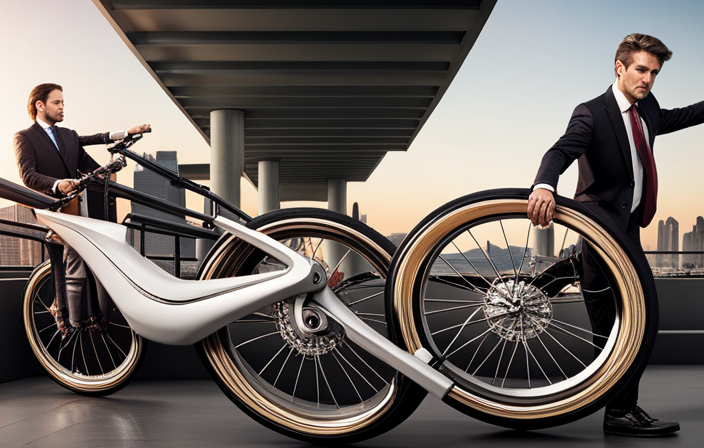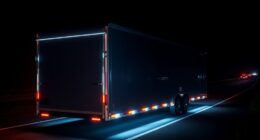How far can an electric bike take you on a single charge?
Imagine effortlessly gliding through the city streets, winding through scenic paths, and conquering challenging terrains, all while leaving a minimal carbon footprint.
In this article, we will explore the range of electric bikes and delve into the factors that affect their distance.
By understanding the various types of electric bikes and adopting smart strategies, you can maximize your ride and embrace a sustainable mode of transportation.
So, let’s dive into the world of electric bike range and discover the possibilities that lie ahead.
Key Takeaways
- Battery capacity is the primary factor determining the range of an electric bike.
- The level of assistance, terrain, rider weight, and weather also impact the range of an electric bike.
- There are different types of electric bikes, including Class 1, Class 2, and Class 3, each with different speed and assistance capabilities.
- Maximizing electric bike range can be achieved through implementing energy-saving strategies, making conscious choices for longer battery life, using pedal assist efficiently, and employing efficient riding techniques.
Understanding Electric Bike Range
You’ll be able to understand electric bike range better by considering factors such as battery capacity and level of assistance. Calculating range is dependent on the battery management system, which determines how efficiently the battery is utilized. A higher battery capacity generally means a longer range, as it can store more energy.
Additionally, the level of assistance provided by the electric motor affects the range. Using a higher level of assistance will consume more battery power and decrease the range. It’s important to note that factors such as terrain, rider weight, and weather conditions can also impact the range.
Understanding these factors will help you choose an electric bike that suits your needs.
Moving on to the subsequent section about types of electric bikes, let’s explore the various options available.
Types of Electric Bikes
When discussing the types of electric bikes, it is essential to understand the different classes they fall into.
Class 1 electric bikes are equipped with a motor that assists while pedaling, enabling you to travel longer distances with ease.
Class 2 electric bikes have a throttle that allows you to ride without pedaling, making them perfect for those who need an extra boost.
Lastly, Class 3 electric bikes provide assistance up to 28 miles per hour, offering a faster and more exhilarating ride.
Class 1 Electric Bikes
Class 1 electric bikes can travel a significant distance on a single charge. When estimating the range without pedal assist, these bikes can typically go up to 50 miles or more. However, it’s important to note that the actual range may vary depending on various factors such as terrain, rider weight, weather conditions, and level of pedal assist used.
To improve battery life and extend the distance covered, riders can take a few measures. Firstly, they can choose a bike with a higher-capacity battery. Secondly, they can use a lower level of pedal assist or even ride without it when possible. Lastly, maintaining an appropriate tire pressure and avoiding excessive weight on the bike can also help conserve battery power.
Class 2 electric bikes, on the other hand, offer a different set of features and capabilities, which we will explore in the next section.
Class 2 Electric Bikes
The range of class 2 electric bikes can vary depending on several factors. Here are some key points to consider when calculating efficiency and battery charging:
-
Battery Capacity: The size of the battery plays a crucial role in determining how far a class 2 electric bike can go. Higher capacity batteries tend to provide a longer range.
-
Terrain: Riding on hilly terrains or rough surfaces can impact the range of the bike. Uphill climbs require more power, reducing the overall distance the bike can cover.
-
Rider’s Weight: Heavier riders may experience a shorter range as the motor needs to work harder to propel the bike.
-
Power Assist Level: The amount of assistance provided by the electric motor can affect the bike’s range. Higher power assist levels consume more battery power, reducing the overall distance.
Considering these factors, class 2 electric bikes offer a range of up to 50 miles per charge.
Now let’s delve into the world of class 3 electric bikes, which offer even more versatility and speed.
Class 3 Electric Bikes
To get the most out of a class 3 electric bike, you should take into account its higher speed capabilities and regulations.
Class 3 electric bikes, also known as speed pedelecs, have a maximum assisted speed of 28 mph. This makes them a great option for those who want a faster and more efficient way to commute or explore.
However, it’s important to note that class 3 electric bikes are subject to certain regulations, such as the need for a helmet and age restrictions.
When it comes to calculating range, factors such as terrain, rider weight, and battery management play a crucial role. By managing your battery usage efficiently and considering these factors, you can maximize the range and enjoy longer rides on your class 3 electric bike.
Moving on to calculating range, it’s important to understand the various factors that impact the distance you can travel on a single charge.
Calculating Range
To calculate the range of your electric bike, there are a few factors to consider. First, you’ll need to understand battery range estimation. This refers to the distance your electric bike can travel on a single charge. It can vary depending on the battery capacity and the power consumption of your bike.
Next, it’s important to understand Wh (watt-hour) and Ah (amp-hour) ratings. These ratings help you determine the energy capacity of your battery. By knowing the energy capacity, you can estimate how far your bike can go before needing to recharge.
Finally, it’s worth considering the use of pedal assist. This feature allows you to extend your bike’s range by utilizing your own power in combination with the electric motor. It’s a great option for those who want to be more environmentally-conscious while riding.
Battery Range Estimation
Battery range estimation for electric bikes can vary depending on factors such as terrain, rider weight, and assist level. To accurately estimate the range of an electric bike, it’s important to consider these factors.
Terrain: Riding uphill or on rough terrain requires more power, reducing the battery range.
Rider Weight: Heavier riders require more energy to propel the bike, resulting in a shorter battery range.
Assist Level: Higher assist levels consume more battery power, reducing the range.
Estimating Range Accuracy: Manufacturers often provide range estimates, but they may not account for real-world conditions like wind resistance.
Understanding battery range estimation is crucial for planning your rides and managing battery usage efficiently. Now, let’s delve into understanding wh and ah ratings to gain further insight into electric bike batteries.
Understanding Wh and Ah ratings
Understanding the Wh and Ah ratings provides valuable insight into the capacity and performance of electric bike batteries.
The Wh (watt-hour) rating represents the total energy capacity of the battery, while the Ah (amp-hour) rating indicates how much current the battery can provide for a specific period.
These ratings are crucial for determining the battery capacity and power consumption of an electric bike. The higher the Wh rating, the longer the battery will last before needing to be recharged. Similarly, a higher Ah rating means the battery can provide more power for longer rides.
By understanding these ratings, you can make informed decisions about which electric bike to choose based on your desired battery capacity and power needs.
This knowledge will be beneficial when estimating range with pedal assist, as we will explore in the next section.
Estimating Range with Pedal Assist
When estimating range with pedal assist, you can gauge how long you’ll be able to ride before needing to recharge the battery. Pedal assist offers several advantages that contribute to a longer range on your electric bike.
First, it allows you to conserve battery power by utilizing your own pedaling strength alongside the electric motor. This not only extends the distance you can travel, but also provides a more engaging and active riding experience.
Second, pedal assist helps in navigating hilly terrains or strong headwinds, as the motor provides additional support, reducing the strain on your legs.
Lastly, factors such as rider weight, terrain, wind conditions, and battery capacity affect the accuracy of range estimation. By considering these factors, you can make more informed decisions about your ride and plan accordingly.
Maximizing electric bike range involves implementing energy-saving strategies and making conscious choices to ensure a longer-lasting battery life.
Maximizing Electric Bike Range
To maximize the range of your electric bike, there are three key areas to focus on: pedal assist levels and efficiency, riding techniques for efficiency, and battery management tips.
Adjusting your pedal assist level can significantly impact how far your bike can go, so find the right balance that provides assistance without draining the battery too quickly.
Riding techniques such as maintaining a steady speed, avoiding sudden accelerations and braking, and utilizing aerodynamic body positions can also help you conserve energy.
Lastly, implementing battery management tips like charging your battery to the recommended level and storing it in a cool, dry place will ensure optimal performance and longevity.
By paying attention to these factors, you can make the most of your electric bike’s range while being environmentally-conscious.
Pedal Assist Levels and Efficiency
You can increase the efficiency of your electric bike by adjusting the pedal assist levels. Here are three ways pedal assist benefits your electric bike and impacts your ride on different terrains:
-
Optimal Power Distribution: Pedal assist allows you to distribute the power between yourself and the electric motor. By finding the right balance, you can maximize the efficiency of your ride and extend the bike’s range.
-
Energy Conservation: Pedal assist helps you conserve energy by reducing the effort required for pedaling. This means you can cover longer distances with less fatigue, making it easier to tackle challenging terrains like hills or uneven surfaces.
-
Adaptive Assistance: Pedal assist adapts to your pedaling speed and effort, providing the right amount of assistance when needed. This ensures that you are using the battery power efficiently and getting the most out of each charge.
By adjusting the pedal assist levels, you can optimize your electric bike’s performance and make the most of your ride.
Transitioning into the next section about riding techniques for efficiency, let’s explore how you can further enhance your electric bike’s range and reduce energy consumption.
Riding Techniques for Efficiency
To enhance the efficiency of your electric bike, try implementing these riding techniques.
By maximizing battery life, you can go further and reduce your environmental impact. One effective technique is to use a steady cadence while pedaling. This means maintaining a consistent speed and avoiding sudden acceleration or deceleration.
Additionally, try to anticipate traffic and use your brakes sparingly. Coasting whenever possible will help conserve energy and extend your battery life. Another tip is to ride in a higher gear when starting from a standstill, as this requires less power from the motor.
Lastly, avoid excessive use of the throttle and rely more on pedal assist. By implementing these eco-friendly riding techniques, you can go the extra mile on your electric bike.
Now let’s delve into some battery management tips.
Battery Management Tips
Implementing effective battery management techniques is essential for maximizing the lifespan and performance of your electric bike. To ensure optimal battery charging and extend battery life, follow these tips:
-
Charge your battery regularly: Consistently charging your battery helps maintain its capacity and prevents it from fully draining.
-
Avoid overcharging: Overcharging can lead to decreased battery life. Disconnect your battery from the charger once it reaches 100%.
-
Store your battery properly: When not in use, store your battery in a cool, dry place. Extreme temperatures can negatively impact battery performance.
-
Avoid deep discharges: Try to avoid completely draining your battery before recharging. Regular, shallow discharges are better for battery longevity.
By following these battery management tips, you can ensure that your electric bike’s battery lasts longer and performs at its best.
In the next section, we will explore real-world examples of electric bikes and their range capabilities.
Real-world Examples
In real-world scenarios, electric bikes can travel a significant distance on a single charge, alleviating range anxiety for riders. Real-life experiences show that electric bikes can cover up to 50 miles on a single charge, depending on various factors such as terrain, rider weight, and level of pedal assist.
For example, a rider in a hilly area with moderate pedal assist can expect a range of around 30 miles, while a rider on flat terrain with minimal pedal assist can achieve a range of up to 50 miles. These numbers may vary, but they highlight the impressive capabilities of electric bikes.
With such range, riders can confidently embark on longer trips, knowing that their electric bikes can take them far.
Transitioning to the next section, there are also extended range solutions available for those seeking even greater distances.
Extended Range Solutions
Looking for ways to increase your travel distance on an electric bike? Explore extended range solutions for even greater mileage. Here are five options to optimize your battery range and go the extra mile:
- Invest in a higher capacity battery pack to increase your bike’s range.
- Consider adding a range extender kit to your bike, which can provide additional power on longer rides.
- Optimize your riding style by utilizing pedal-assist mode and adjusting your speed to maximize efficiency.
- Use regenerative braking, which converts kinetic energy into electrical energy and can help extend your battery life.
- Plan your routes in advance to avoid steep inclines and choose flatter terrain, which requires less power.
By implementing these extended range solutions and focusing on battery range optimization, you can enjoy longer rides on your electric bike.
And when it comes to maintenance and care, there are additional steps you can take to keep your bike in top condition.
Maintenance and Care
To keep your electric bike in top condition, you should regularly perform maintenance tasks such as cleaning and lubricating the chain, checking tire pressure, and inspecting the brakes. Proper battery maintenance is also crucial for optimal performance. Make sure to charge the battery fully before each ride and avoid overcharging it. Additionally, store the battery in a cool, dry place when not in use. Troubleshooting tips can come in handy when facing any issues with your electric bike. If you experience a sudden decrease in range, try checking the tire pressure, as underinflated tires can cause increased friction and reduce battery life. Another common problem is a loose connection, so ensure all cables are securely connected. By following these maintenance and troubleshooting tips, you can maximize the lifespan of your electric bike and enjoy longer rides. Speaking of range, let’s debunk some common electric bike range myths.
Electric Bike Range Myths
Are you worried about running out of battery while riding an electric bike? Don’t be! Electric bike range myths often perpetuate the anxiety of running out of battery, but in reality, most electric bikes have a range of 40-100 miles per charge, depending on various factors such as terrain, rider weight, and speed.
Comparing electric bikes to cars, electric bikes are much more energy-efficient and environmentally-friendly, emitting significantly less greenhouse gases.
While it’s true that electric bikes have a trade-off between range and speed, with higher speeds consuming more battery power, it’s important to note that most electric bikes can still reach speeds of up to 20-28 mph, which is sufficient for most urban and suburban commutes.
"Running Out of Battery" Anxiety
Don’t worry about running out of battery on your electric bike. With advancements in battery technology and more accurate estimating systems, you can easily overcome range anxiety. Here’s why:
-
Improved battery life estimation: Electric bikes now come with sophisticated systems that provide accurate predictions of how far you can go on a single charge. These systems take into account factors like terrain, rider weight, and assist level, ensuring you have a clear understanding of your bike’s range.
-
Overcoming range anxiety: Many electric bike riders have found that their initial concerns about running out of battery were unfounded. With proper planning, understanding your bike’s capabilities, and utilizing charging infrastructure, you can confidently enjoy long rides without the fear of getting stranded.
Transitioning into the next section, comparing electric bikes to cars, you’ll see how electric bikes offer a more sustainable and efficient mode of transportation.
Comparing Electric Bikes to Cars
Electric bikes can be a more sustainable and efficient mode of transportation when compared to cars. Not only do they produce zero emissions, but they also require less energy and resources to manufacture.
When it comes to comparing electric bikes to public transportation, electric bikes offer the advantage of flexibility and convenience. They allow you to travel directly from point A to point B without the need for transfers or waiting for schedules.
Furthermore, electric bikes can also be a great alternative to motorcycles. They provide a similar level of speed and agility while being much quieter and emitting zero emissions.
However, it’s important to note that electric bikes do have limitations in terms of range compared to cars. With that in mind, let’s explore the trade-offs between range and speed in the next section.
Range vs. Speed Trade-offs
The trade-offs between range and speed on electric bikes can impact their overall performance.
When it comes to range, one important trade-off is with weight. Generally, the heavier the electric bike, the shorter the range it will have. This is because the motor has to work harder to move a heavier bike, draining the battery faster.
Another trade-off is with terrain. Electric bikes tend to have a shorter range when riding on hilly or uneven terrain compared to flat surfaces. This is because the motor has to exert more power to climb hills or traverse rough terrain, which again drains the battery faster.
So, if you’re looking for an electric bike with a longer range, it’s important to consider the weight and the type of terrain you’ll be riding on.
In the next section, we’ll explore future developments in electric bike range, including advancements in battery technology.
Future Developments in Electric Bike Range
In the future, you can expect to see advancements in battery technology, efficient motor and drive systems, and the integration of renewable energy sources in electric bikes.
These developments will greatly increase the range of electric bikes and make them even more environmentally friendly. Imagine being able to go on longer rides without worrying about running out of battery power, thanks to improved battery technology.
With more efficient motor and drive systems, electric bikes will be able to cover greater distances with less energy consumption.
Additionally, the integration of renewable energy sources will allow electric bikes to recharge their batteries using clean and sustainable energy, reducing their carbon footprint even further.
Advancements in Battery Technology
You’ll be amazed at how far your electric bike can go with advancements in battery technology. These developments have greatly improved the range of electric bikes, allowing riders to travel longer distances without worrying about running out of power. Here are some factors that contribute to the increased range:
-
Battery charging techniques: New charging techniques, such as fast charging and regenerative braking, enable quicker and more efficient charging, reducing downtime and increasing the overall range of the electric bike.
-
Impact of weight on electric bike range: Lighter batteries and other components have been developed, reducing the weight of electric bikes. With less weight to carry, the bike can travel further on a single charge.
-
Higher energy density: Battery technology has advanced to provide higher energy density, meaning that more energy can be stored in a smaller battery, further extending the electric bike’s range.
-
Improved battery management systems: Modern electric bikes are equipped with sophisticated battery management systems that optimize energy usage, ensuring a more efficient and longer-lasting battery life.
With these advancements in battery technology, electric bikes are now capable of traveling longer distances, making them a viable and sustainable mode of transportation.
Moving on to the next section, let’s explore the efficiency of motor and drive systems.
Efficient Motor and Drive Systems
Advancements in battery technology have greatly contributed to the increased range of electric bikes. But it’s not just the batteries that play a role in determining how far an electric bike can go. The efficient motor and drive systems also play a crucial part in maximizing the bike’s range.
Efficient motor design is key to ensuring that the electric bike can convert battery power into motion with minimal energy loss. Additionally, regenerative braking technology allows the bike to recover energy during braking and store it back into the battery, further enhancing its range.
To better understand the impact of efficient motor design and regenerative braking technology on electric bike range, let’s take a look at the following table:
| Motor Efficiency | Regenerative Braking Efficiency | Electric Bike Range |
|---|---|---|
| High | High | Extended |
| Medium | Medium | Moderate |
| Low | Low | Limited |
By optimizing these factors, electric bike manufacturers are continuously pushing the boundaries of how far these bikes can go. In the next section, we will explore the integration of renewable energy sources to further enhance the sustainability of electric bikes.
Integration of Renewable Energy Sources
To enhance the sustainability of your electric bike, consider integrating renewable energy sources. By harnessing the power of the sun or wind, you can extend the range of your bike and reduce your reliance on traditional energy sources.
Renewable energy integration is becoming increasingly popular in electric bike design, as it offers a clean and efficient way to charge your bike’s battery. Solar panels can be installed on the bike itself or on a charging station at your home or workplace. Wind turbines can also be used to generate electricity, especially if you live in a windy area.
By incorporating these renewable energy sources into your electric bike, you can not only increase its range but also reduce your carbon footprint. This ensures that you are not only enjoying the benefits of a greener mode of transportation, but also actively contributing to the preservation of our environment.
In conclusion, integrating renewable energy sources into your electric bike is a smart and sustainable choice.
Conclusion and Final Thoughts
In conclusion, it’s impressive to see how far electric bikes have come and the potential they hold for the future.
Electric bikes have made significant advancements in maximizing battery life, allowing riders to travel longer distances without worrying about running out of power. Regular maintenance is also crucial to ensure the optimal performance and longevity of the bike’s battery.
By keeping the battery clean, checking for any signs of damage, and following the manufacturer’s recommended maintenance schedule, riders can extend the lifespan of their electric bike and maximize its efficiency.
Additionally, it is important to mention that electric bikes are environmentally-conscious alternatives to traditional gas-powered vehicles. They produce zero emissions, reducing air pollution and contributing to a cleaner and greener future.
With ongoing advancements in technology, electric bikes continue to evolve and offer a sustainable mode of transportation.
Frequently Asked Questions
Are electric bikes more expensive to maintain compared to traditional bikes?
Electric bikes tend to be more expensive to maintain compared to traditional bikes. This is due to their complex electrical components and the need for regular battery maintenance. However, the cost comparison is offset by the environmental benefits and potential savings on fuel.
Can I ride my electric bike in the rain without causing damage to the battery?
To protect your electric bike battery while riding in wet conditions, make sure it’s properly sealed and avoid submerging it. Dry it thoroughly afterwards and store your bike in a dry place. Follow these tips to extend your battery’s lifespan and reduce environmental impact.
Is it possible to upgrade the battery on my electric bike to increase its range?
Yes, you can upgrade the battery on your electric bike to increase its range. This will also enhance the battery lifespan and requires regular maintenance. Upgrading the battery allows for longer, more environmentally-friendly rides.
How long does it take to fully charge the battery of an electric bike?
To fully charge the battery of an electric bike, it typically takes around 4-6 hours. However, charging times may vary depending on the battery capacity and charger used. It’s important to note that frequent charging can affect the overall lifespan of the battery.
Are there any government incentives or subsidies available for purchasing an electric bike?
There are government incentives and subsidies available for purchasing electric bikes. These programs aim to promote eco-friendly transportation options and reduce carbon emissions. Take advantage of these incentives to make your electric bike purchase more affordable and sustainable.
Conclusion
So there you have it, now you know all about how far electric bikes can go. With an understanding of electric bike range, different types of bikes, and how to calculate and maximize range, you can make informed choices when it comes to purchasing and using an electric bike.
Remember to take good care of your bike and perform regular maintenance to ensure optimal performance. And don’t be fooled by myths surrounding electric bike range – the technology is constantly improving.
As we look to the future, we can expect further developments in electric bike range, allowing us to travel even greater distances on these environmentally-conscious modes of transportation.
So why wait? Get on your electric bike and let the world be your oyster!









